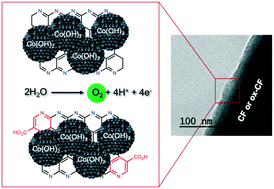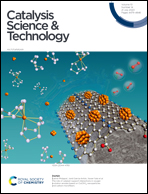The role of catalyst–support interactions in oxygen evolution anodes based on Co(OH)2 nanoparticles and carbon microfibers†
Abstract
The performance of OER anodes based on supported nanocatalysts is highly dependent on the interactions taking place at the interface between the nanocatalyst and the employed conductive support. Herein, the versatility offered by the organometallic approach for the synthesis of metal-based nanostructures allowed preparing electrodes of tailored nanocatalyst–support interactions. A set of OER working electrodes based on Co(OH)2 nanoparticles (NPs) and carbon microfibers (CFs) were prepared. The so-obtained systems differ in either the stabilizer present at the surface of the NPs (THF or 1-heptanol), the surface functionalization of the used CFs (bare CFs or oxidized-CFs) or the growth of the NPs in the presence (in situ) or the absence (ex situ) of the carbonaceous support. Correlation of a detailed structural and compositional analysis with the electroactivity of the tested nanomaterials allows extracting valuable insights about the influence of the metal–support interface on the OER performance of the studied anodes.



 Please wait while we load your content...
Please wait while we load your content...